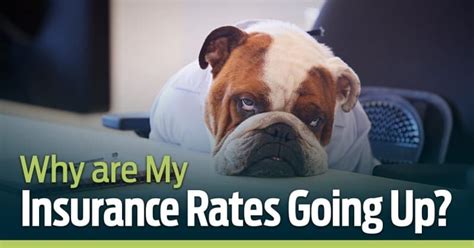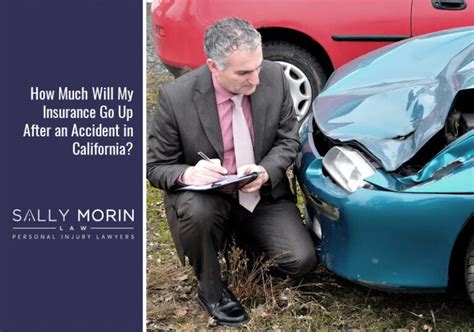Why Does My Insurance Go Up

When it comes to insurance, one of the most common questions that policyholders have is, "Why does my insurance premium go up?" Understanding the factors that influence insurance rates is crucial for consumers to make informed decisions and manage their financial obligations effectively. In this comprehensive article, we will delve into the various reasons behind increasing insurance costs, explore real-world examples, and provide valuable insights to help you navigate the insurance landscape.
The Complex Web of Insurance Rate Determinants

Insurance premiums are not arbitrary numbers plucked out of thin air; they are carefully calculated based on a multitude of factors that reflect the risk associated with insuring an individual or property. These factors vary depending on the type of insurance, such as auto insurance, home insurance, or health insurance, but some common themes exist across the industry.
Risk Assessment: A Precise Science
At the core of insurance rate determination lies risk assessment, a meticulous process that involves evaluating numerous variables to gauge the likelihood of a claim occurring. Insurers employ sophisticated algorithms and statistical models to analyze historical data, trends, and external factors to predict future risks accurately.
For instance, in auto insurance, risk assessment considers factors like the driver's age, gender, driving record, and the make and model of the vehicle. Younger drivers, statistically, tend to have higher accident rates, leading to increased premiums. Similarly, individuals with a history of accidents or traffic violations are viewed as higher-risk, resulting in higher insurance costs.
| Risk Factor | Impact on Insurance Rates |
|---|---|
| Age | Younger drivers often pay more due to higher accident rates. |
| Driving Record | Accidents and violations can lead to significant premium increases. |
| Vehicle Type | Sports cars or luxury vehicles may attract higher premiums due to their expense and performance. |

Geographical Considerations
The location where you live or operate your business plays a pivotal role in insurance rate determination. Geographical factors influence the likelihood and severity of certain risks, such as natural disasters, crime rates, and traffic congestion.
Consider a homeowner's insurance policy in an area prone to hurricanes. The insurer will assess the historical data of hurricane damage in that region and adjust premiums accordingly. Similarly, a business owner's insurance in a high-crime area may face higher premiums to account for the increased risk of theft or vandalism.
| Geographical Factor | Impact on Insurance Rates |
|---|---|
| Natural Disaster Zones | Areas prone to hurricanes, earthquakes, or floods often have higher insurance costs. |
| Crime Rates | High-crime areas may result in elevated premiums for business and home insurance. |
| Traffic Congestion | Heavily congested areas may impact auto insurance rates due to increased accident risks. |
The Ever-Changing Landscape of Insurance Claims
Insurance rates are dynamic and can fluctuate over time due to changes in claim trends and costs. When insurers experience an increase in claims or rising costs associated with paying out claims, they may adjust premiums to maintain their financial stability.
For example, let's examine the impact of a major natural disaster on insurance rates. In the aftermath of a devastating hurricane, insurers may face an influx of claims for property damage. To recoup these costs and maintain solvency, they may increase premiums for policyholders in affected areas.
Similarly, in health insurance, rising medical costs and changing healthcare regulations can influence premium adjustments. Insurers must carefully monitor these trends to ensure they can provide coverage while remaining financially viable.
Policyholder Behavior and Lifestyle Choices
The actions and choices of policyholders themselves can significantly impact insurance rates. Insurers closely monitor policyholder behavior and adjust rates based on the perceived level of risk associated with that behavior.
In the case of auto insurance, driving habits play a crucial role. Frequent speeding tickets or accidents can lead to higher premiums as insurers view these individuals as higher-risk drivers. Conversely, safe driving habits and a clean record may result in discounts or lower premiums.
Similarly, in health insurance, lifestyle choices such as smoking, excessive alcohol consumption, or engaging in high-risk activities can influence premium rates. Insurers may offer incentives for policyholders to adopt healthier lifestyles, leading to potential savings on insurance costs.
Industry Trends and Regulatory Changes

The insurance industry is not immune to the influence of broader economic and regulatory trends. Changes in the economic landscape, legislative policies, and industry innovations can all impact insurance rates.
Economic Fluctuations and Inflation
Economic fluctuations, such as recessions or periods of high inflation, can affect insurance rates. During economic downturns, insurers may face increased claims due to financial hardship, leading to premium adjustments to maintain profitability.
Inflation, in particular, can have a significant impact on insurance costs. As the cost of goods and services rises, insurers must adjust their rates to account for the increased expense of paying out claims. This ensures that they can provide adequate coverage while maintaining financial stability.
Regulatory Changes and Market Competition
Regulatory bodies play a crucial role in shaping the insurance landscape. Changes in insurance laws and regulations can directly influence insurance rates. For example, the implementation of new mandated coverages or consumer protection measures may require insurers to adjust their pricing structures.
Market competition also plays a role in insurance rate determination. In highly competitive markets, insurers may offer discounts or promotional rates to attract new customers. Conversely, in less competitive markets, insurers may have more flexibility in setting rates, leading to potential increases.
Technological Advancements and Data Analytics
The rapid advancement of technology and data analytics has revolutionized the insurance industry. Insurers now have access to vast amounts of data and advanced analytical tools, enabling them to make more precise risk assessments and pricing decisions.
For instance, the use of telematics in auto insurance allows insurers to track driving behavior and offer usage-based insurance policies. These policies reward safe drivers with lower premiums, while those with riskier driving habits may face higher rates. This data-driven approach ensures a more accurate assessment of risk and promotes safer driving practices.
The Future of Insurance: Navigating Uncertainty
As we look ahead, the insurance industry is poised for continued evolution and innovation. Emerging technologies, such as artificial intelligence and machine learning, are expected to play an increasingly significant role in risk assessment and pricing models.
Additionally, the growing focus on sustainability and environmental considerations is likely to impact insurance rates. Insurers are increasingly incorporating climate change risks and sustainability initiatives into their risk assessments, which may lead to adjustments in premiums for policyholders.
Policyholders must stay informed about these developments to make informed decisions about their insurance coverage. Regularly reviewing insurance policies and comparing rates with other providers can help ensure you are getting the best value for your insurance needs.
Conclusion: Empowering Consumers with Knowledge
Understanding the factors that influence insurance rates is essential for consumers to navigate the insurance landscape effectively. By recognizing the complex interplay of risk assessment, geographical considerations, claim trends, industry trends, and technological advancements, policyholders can make informed choices and advocate for their financial well-being.
As the insurance industry continues to evolve, staying informed and proactive is key. Regularly reviewing insurance policies, understanding the factors that impact rates, and seeking out competitive quotes can help consumers manage their insurance costs and ensure they have the coverage they need at a fair price.
How often do insurance rates change?
+Insurance rates can change periodically, typically once a year. However, insurers may adjust rates more frequently based on various factors, such as changes in claim trends, regulatory updates, or economic fluctuations.
Can I negotiate my insurance premium?
+While insurance premiums are largely determined by standardized risk assessment models, some flexibility exists. You can negotiate with your insurer by providing additional information about your risk profile or exploring potential discounts. However, it’s important to remember that insurers have guidelines and regulations they must follow when setting rates.
What can I do to lower my insurance costs?
+There are several strategies you can employ to lower your insurance costs. These include shopping around for competitive quotes, maintaining a clean driving or claim history, opting for higher deductibles, and exploring loyalty or multi-policy discounts. Additionally, staying informed about industry trends and economic factors can help you anticipate potential rate changes.



